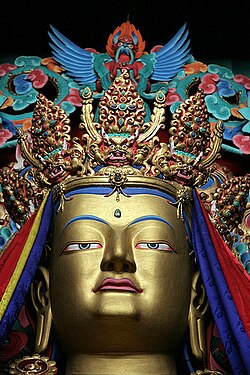Bon
Bon or Bön (T. bon བོན་), also known as Yungdrung Bon (T. g.yung drung bon གཡུང་དྲུང་བོན་; literally "eternal Bon"), is an indigenous Tibetan religion which shares many similarities with Tibetan Buddhism.[1] It initially developed in the tenth and eleventh centuries[2] but retains elements from earlier religious traditions.[3][4] Bon is a significant minority religion in Tibet, especially in the east, as well as in the surrounding Himalayas.[1][4]
The relationship between Bon and Tibetan Buddhism has been a subject of debate. According to the modern scholar Geoffrey Samuel, while Bon is "essentially a variant of Tibetan Buddhism" with many resemblances to Nyingma, it also preserves some genuinely ancient pre-Buddhist elements.[1] David Snellgrove likewise sees Bon as a form of Buddhism, albeit a heterodox kind.[5] Similarly, John Powers writes that "historical evidence indicates that Bön only developed as a self-conscious religious system under the influence of Buddhism".[6]
Followers of Bon, known as "Bonpos," believe that the religion originated in a kingdom called Zhangzhung, located around Mount Kailash in the Himalayas.[7] Bonpos hold that Bon was brought first to Zhangzhung, and then to Tibet.[8] Bonpos identify the Buddha Shenrab Miwo (Wylie: gshen rab mi bo) as Bon's founder, although no available sources establish this figure's historicity.[9]
Western scholars have posited several origins for Bon, and have used the term "Bon" in many ways. A distinction is sometimes made between an ancient Bon (Wylie: bon rnying), dating back to the pre-dynastic era before 618 CE; a classical Bon tradition (also called Yungdrung Bon – Wylie: g.yung drung bon) which emerged in the 10th and 11th centuries;[10] and "New Bon" or Bon Sar (Wylie: bon gsar), a late syncretic movement dating back to the 14th century and active in eastern Tibet.[11][12][13]
- Further reading
 Bon, Wikipedia
Bon, Wikipedia
Notes
- ↑ 1.0 1.1 1.2 Samuel 2012, pp. 220–221.
- ↑ Kværne, Per (1995). The Bon Religion of Tibet: The Iconography of a Living Tradition. Boston, Massachusetts: Shambhala. p. 13. ISBN 9781570621864. Retrieved 4 November 2022.
According to its own historical perspective, Bon was introduced into Tibet many centuries before Buddhism and enjoyed royal patronage until it was finally supplanted by the 'false religion' (i.e. Buddhism) from India ...
- ↑ Samuel 2012, p. 220.
- ↑ 4.0 4.1 Kvaerne 1996, pp. 9–10.
- ↑ Powers 2007, pp. 500–501
- ↑ Powers (2007), p. 497.
- ↑ Karmay, Samten G., "Extract from 'A General Introduction to the History and Doctrines of Bon'", in Alex McKay, ed. History of Tibet, Volume 1 (New York: Routledge, 2003), 496–9.
- ↑ Namdak, Lopon Tenzin, Heart Drops of Dharmakaya (Ithaca: Snow Lion Publications, 2002).
- ↑ Karmay, 499.
- ↑
Kang, Xiaofei; Sutton, Donald S. (2016). "Garrison City in the Ming: Indigenes and the State in Greater Songpan". Contesting the Yellow Dragon: Ethnicity, Religion, and the State in the Sino-Tibetan Borderland, 1379–2009. Religion in Chinese Societies ISSN 1877-6264, Volume 10. Leiden: Brill. p. 32. ISBN 9789004319233. Retrieved 4 November 2022.
[...] Yungdrung Bon [...] emerged in the 10th and 11th centuries, along with the second rise of Buddhism in Tibet, and continues as a minority practice among Tibetans in both the People's Republic and overseas.
- ↑ Achard, Jean-Luc (2015). "On the Canon Bönpo of the Collège de France Institute of Tibetan Studies". La Lettre du Collège de France. Collège de France (9): 108–109. doi:10.4000/lettre-cdf.2225
 . Retrieved 2021-02-15.
. Retrieved 2021-02-15.
- ↑ Keown, Damien (2003). Oxford Dictionary of Buddhism. Oxford University Press. ISBN 0-19-860560-9.
- ↑ Achard, Jean Luc. "The Three Kinds of Bon (The Treasury of Lives: A Biographical Encyclopedia of Tibet, Inner Asia and the Himalayan Region)". The Treasury of Lives. Retrieved 2022-01-28.
| This article includes content from Bon on Wikipedia (view authors). License under CC BY-SA 3.0. |
